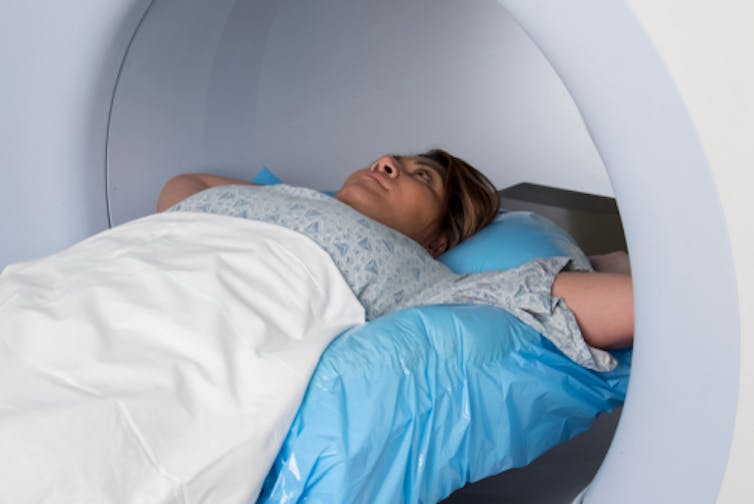Physical therapy important for women treated for breast cancer
While more women than ever are surviving breast cancer, they often do so with bad side effects. Studies are showing that physical therapy early in the post-treatment phase can help.

The survival rate for breast cancer, the most commonly diagnosed cancer among women, is now about 90 percent, increased by nearly 20 percent since the 1970s.
With more women than ever – nearly 3 million – living beyond a breast cancer diagnosis, it’s important to consider how a woman lives after treatment. While many women with cancer are grateful to move on after treatment, the harsh treatments can cause problems for daily activities. These side effects persist or develop many years after diagnosis. Women need to be aware of these effects to watch out for them and get care before they become a problem.
Typically, women with breast cancer undergo some level of surgery. The least invasive is a lumpectomy, wherein only the tumor is removed and much of the breast tissue can be conserved. The second most invasive is a mastectomy, which involves the removal of all of the breast tissue. Typically, the most invasive of all is removal of lymph nodes in the armpit region, or something called a axillary lymph node dissection, on the side of the cancer.
These surgeries are often followed by intense chemotherapy and radiation therapy treatments. The results and side effects of the surgery and treatments can harm overall function and ultimately quality of life.
As a physical therapist and researcher, I have studied the effects of cancer and its treatments on daily function – especially arm use in women with breast cancer – for over a decade. The good news is that physical therapy can help women recover and return to full activity after cancer treatments.
Arms that won’t stop hurting
Surgical removal of lymph nodes places women at risk for a chronic condition that causes swelling, typically in the arms or legs called lymphedema, which affects anywhere from 10 percent to 30 percent of women, depending on the type of surgery and radiation treatment received.
Chemotherapies, especially a class of drugs called taxanes, often result in damage to the nerves in the hands and feet, or what is called peripheral neuropathies, or damage to peripheral nerves. This affects the balance – or vestibular – system and fine motor control, such as the ability to hold a pen or type on a computer. Impaired balance places people at risk for falls, a major cause of disability and death in people 65 and older. Taxanes and another type of drugs called anthracyclines can damage the heart, sometimes resulting in heart failure.

The amount of radiation that women receive during radiation therapy is less than for women treated years ago but still remains problematic. While radiation is often lifesaving, it comes with serious side effects that can persist for years after treatment. The tissues in the radiation field, or the area exposed to radiation, become stiffer and more fibrotic, or thickened, over time. This includes all tissues in the field, which sometimes includes the heart, in addition to the muscles and ligaments in the chest.
As tissues stiffen, women can experience a loss of motion, which can limit their ability to participate in sports, complete work or household chores and even their abilities to shower and dress. It can affect what may seem like simple things, such as fitting into a long-sleeved blouse or blazer.
Removing large numbers of lymph nodes, having more invasive surgery, and being overweight or obese places women at [risk for more late effects such as lymphedema] The problem with these risk factors is that there is no magic number: no magic number of lymph nodes, no magic weight. And, not everyone who has aggressive surgery ends up developing lymphedema. Also, even women who undergo the least invasive surgery, or lumpectomy, still can experience lymphedema.
New treatments and approaches emerging
Many of these side effects can either be prevented or managed effectively, but only if they are addressed in a timely fashion. One model of care, with substantial evidence of effectiveness, is the Prospective Surveillance Model. This method advocates for baseline testing prior to cancer surgery, followed by interval surveillance after the surgical and medical treatments take place. By completing baseline testing, any deficits that might hinder effective medical treatment – such as being able to assume the position necessary for radiation – can be addressed prior to cancer treatment.
And the measures taken at this visit become the benchmark that aftercare visits are measured against. While this is not the standard of care yet, many of us in the physical therapy profession who work with breast cancer survivors hope that it one day will be. Just as people see a dentist twice a year for preventative checkups, those with breast cancer would attend periodic checkups by a physical therapist after treatment to ensure healing is not sidelined. Following individuals in a scheduled periodic fashion after surgery and medical treatments allows for early detection of problems so that intervention can address these little problems before they become big problems.
One example is the development of lymphedema. In a study of 196 women with a diagnosis of breast cancer, women with a 3 percent difference in size of the arm from baseline were provided with a compression garment and taught self-management and massage of the limb. Early intervention reversed the development of lymphedema, and these gains were maintained even four to five months after intervention.
While the ideal practice model is addressing issues before they arise, many women are treated in systems without this model and are instead treated after surgery, radiation or chemotherapy treatment.
Physical therapists also play an important role treating side effects that arise after treatment. Physical therapists are movement experts, and are well-qualified to treat deficits in strength, motion and balance.
This includes restoring function after breast cancer treatment. Multiple studies have investigated the safety of physical activity after breast cancer treatment and found there is minimal risk for the development of lymphedema with most exercise.
In a large trial 154 women at risk for lymphedema participated in a progressive strengthening exercise program with no top limit to the amount of weight lifted. Women who participated in the weight lifting exercise developed lymphedema at lower rates that the no exercise population did. In a small pilot study examining the impact of yoga on arm volume in women with lymphedema, all participants saw a decline in arm volume after an eight-week program.
Physical therapists also play an important role in treating lymphedema. Many physical therapists have specialized training in lymphedema management and are certified lymphedema therapists. These specialized practitioners utilize a massage specific to lymphedema, compression bandages and garments, and exercise, to treat the lymphedema.
With 2.8 million women living beyond a cancer diagnosis in the United States, returning to previous activity levels is important. Early intervention and ongoing surveillance promoted by the Prospective Surveillance Model ensures that these women can get back to what is important to them - living.
Mary Insana Fisher receives funding from the University of Dayton and the American Physical Therapy Association for research. She is affiliated with the American Physical Therapy Association.
Read These Next
West Antarctica’s history of rapid melting foretells sudden shifts in continent’s ‘catastrophic’ geo
A picture of what West Antarctica looked like when its ice sheet melted in the past can offer insight…
How the ‘slayer rule’ might play a role in determining who will inherit wealth from Rob Reiner and h
These rules have a long history in the United States. They played a role in the notorious murders by…
The celibate, dancing Shakers were once seen as a threat to society – 250 years later, they’re part
‘The Testament of Ann Lee,’ Mona Fastvold’s 2025 film, depicts part of the long history of Shaker…






